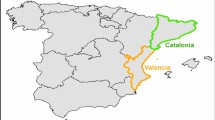Abstract
Commencing with the work carried out during the epidemiological survey of amyotrophic lateral sclerosis in the period 1980–1992 and the pathology follow-up, we carried out a perspective incidence, prevalence and mortality survey of X-linked bulbar and spinal muscular atrophy (X-BSMA) in the province of Reggio Emilia in Northern Italy. Based on 11 patients (eight familial and three sporadic cases), the mean incidence per year for the period 1980 through 1997, as evaluated at the onset of symptoms, was 0.09 cases/100,000 for the total population and 0.19 cases/100,000 for the male population. On December 31, 1997, the prevalence rate was 1.6/100,000 for the total population and 3.3/100,000 for the male population. In the 18-year period of 1980–1997, the average yearly mortality rate was: 0.03 cases/100,000 per year for the total population and 0.06 cases/100,000 for the male population. The average age at onset was 44.8 ± 10.1, and the average survival period was 27.3 ± 2.3 years. The average age of the prevalence day was 58.9 ± 14.9, and the average age at death was 71.3 ± 4.7 years. Whereas the incidence rate of X-BSMA in the province of Reggio Emilia is 16 times lower that of amyotrophic lateral sclerosis (ALS), the incidence rate of progressive bulbar palsy in the male population is only slightly higher than X-BSMA; and the prevalence rate of ALS for males is two times the prevalence rate for X-BSMA, with overlapping of confidence intervals. X-BSMA is a rare disease, which is probably under-diagnosed, but due to the long survival period of this disease its frequency is not negligible. Because of the presence of sporadic cases or non-evident familial cases, it is appropriate to consider this diagnostic possibility in making a diagnosis of ALS in patients in whom lower motor neuron dysfunction or bulbar onset predominates.
Similar content being viewed by others
References
Kennedy WR, Alter M, Sung JH. Progressive proximal spinal and bulbar atrophy of late onset. A sex linked recessive trait. Neurology 1968; 18: 671–680.
Barkhaus PE, Kennedy WR, Stern LZ, Harrington RB. Hereditary proximal spinal and bulbar neuron disease of late onset. Arch Neurol 1982; 39: 112–116.
Guidetti D, Motti L, Marcello N, et al. Kennedy disease in an Italian kindred. Eur Neurol 1986; 25: 188–196.
Guidetti D, Vescovini E, Motti L, et al. X-linked bulbar and spinal muscular atrophy, or Kennedy disease: Clinical, neurophysiological, neuropathological, neuropsychological and molecular study of a large family. J Neurol Sci 1996; 135: 140–148.
Sobue G, Doyon M, Kachi T, et al. Subclinical phenotypic expression in heterozygous females of X-linked recessive bulbospinal neuronopathy. J Neurol Sci 1993; 117, 74–78.
La Spada AR, Wilson EM, Kubahn DB, Harding AE, Fischbeck KH. Androgen receptor gene mutations in X-linked spinal and bulbar muscular atrophy. Nature 1991; 352: 77–79.
Wieacker PF, Knoke I, Jukubiczka S. Clinical and molecular aspects of androgen receptor defects. Exp Clin Endocrinol Diabetes 1998; 106: 446–452.
La Spada AR, Roling DB, Harding AE, et al. Meiotic stability and genotype-phenotype correlation of the trinucleotiderepeat in X-linked spinal and bulbar muscular atrophy. Nature Genet 1992; 2: 301–304.
Lumbroso S, Lobaccaro JM, Vial C, et al. Molecular analysis of the androgen receptor gene in Kennedy's disease. Horm Res 1997; 47: 23–29.
Li M, Miwa S, Kobayashi Y, et al. Nuclear inclusions of the androgen receptor protein in spinal and bulbar muscular atrophy. Ann Neurol 1998; 44: 249–254.
Li M, Nakagomi Y, Kobayashi Y, et al. Nonneural nuclear inclusions of androgen receptor protein in spinal and bulbar muscular atrophy. Am J Pathol 1998; 153: 695–701.
Elliby LM, Hackam AS, Propp HM, et al. Kennedy's disease: Caspase cleavage of the androgen receptor is a crucial event in cytotoxicity. J Nurochem 1999; 72: 185–195.
Kobayashi Y, Miwa S, Merry DE, et al. Caspase-3 cleaves the expanded androgen receptor protein of spinal and bulbar muscular atrophy in a polyglutamine repeat length-dependent manner. Biochem Biophys Res Commun 1998; 252: 145–150.
Nakamura M, Mita S, Matuura T, et al. The rediction of androgen receptor mRNA in motoneurons of X-linked spinal and bulbar muscular atrophy. J Neurol Sci 1997, 150: 161–165.
Terao S, Sobue G, Li M, Hashizume Y, Tnaka F, Mitsuma T. The lateral corticospinal tract and spinal ventral horn in X-linked recessive spinal and bulbar muscular atrophy: A quantitative study. Acta neuropathol 1997; 93: 1–6.
Li M, Sobue G, Doyu M, Mukai E, Hashizume Y, Mitsuma T. Primary sensory neurons in X-linked recessive bulbospinal neuronopathy: Histopathology and androgen receptor gene expression. Muscle Nerve 1995; 18: 301–308.
Teatini APF, D'Anna S, Manganotti P, et al. Sensory involvement in X-linked spino-bulbar muscular atrophy (Kennedy's syndrome): An electrophysiological study.
Guidetti D, Bondavalli M, Sabadini R, et al. Epidemiological survey of amyotrophic lateral sclerosis in the province of Reggio Emilia, Italy: Influence of environmental exposure to lead. Neuroepidemiology 1996; 15: 301–312.
Ferlini A, Patrosso MC, Merlini D, et al. Androgen receptor gene CAG repeat analysis in the di.erential diagnosis between Kennedy disease and other motoneuron disease. Am Hum Genet 1994; 53: 1–8.
Schoenberg BS. Calculating con.dence intervals for rates and ratios. Simpli.ed method utilizing tabular values based on the Poisson distribution. Neuroepidemiology 1983; 257–265.
Parboosingh JS, Figlewicz DA, Krizus A, et al. Spinobulbar muscular atrophy can mimic ALS: The importance of genetic testing in male patients with atypical ALS. Neurology 1997; 49: 568–572.
Igarashi S, Yonemochi K, Tanaka K, Inuzuka TK. Atypical clinical presentations of X-linked Spinal and bulbar muscular atrophy in patients with mild CAG expansion in androgen receptor gene. Eur Neurol 1997; 38: 310–312.
Yamada M, Inaba A, Shiojiri T. X-linked spinal and bulbar muscular atrophy with myasthenic symptoms. J Neurol Sci 1997; 146: 183–185.
Author information
Authors and Affiliations
Rights and permissions
About this article
Cite this article
Guidetti, D., Sabadini, R., Ferlini, A. et al. Epidemiological survey of X-linked bulbar and spinal muscular atrophy, or Kennedy disease, in the province of Reggio Emilia, Italy. Eur J Epidemiol 17, 587–591 (2001). https://doi.org/10.1023/A:1014580219761
Issue Date:
DOI: https://doi.org/10.1023/A:1014580219761




